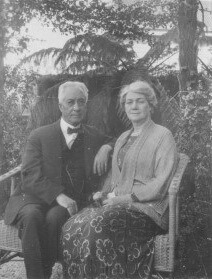The Bahá’í Faith in Australia
The Bahá'í Faith has a long history in Australia. The first-known mention of the Faith in Australian newspapers came in 1846, but during the next few decades there were only sporadic references to the religion. A turning point came in 1916 with a comment on Australia made by `Abdu'l-Bahá, the son of the Founder of the Faith. In 1920, U.K./ American emigrants John Henry Hyde Dunn and Clara Dunn came to Australia, where they found people receptive to the teachings of Baha’u’llah in several cities. Bahá’ís have continued to immigrate to Australia.

In 1923, the Bahá'ís of Melbourne elected their Local Spiritual Assembly, the first in Australia. Most
of the nine members were single or widowed women. In 1934, the first National Spiritual Assembly was
elected.
Iranian Bahá'ís had first tried to emigrate to Australia in 1948 but were rejected as "Asiatic" by
Australia's White Australia policy. The situation eased in the 1960s and 70s. On the eve of Iranian
revolution in 1978, there were approximately 50-60 Persian Bahá'í families in Australia. However,
Persians, including Bahá'ís, started to arrive in great number following the revolution and persecution
of Bahá'ís in Iran.
Since the 1980s, the Bahá'ís of Australia have become involved and spoken out on a number of civic
issues - from interfaith initiatives such as Soul Food to conferences on indigenous issues and national
policies of equal rights and pay for work. The community was counted in the 2001 census to consist of
about 11,000 individuals. The Association of Religion Data Archives (relying on the World Christian
Encyclopedia) estimated some 17,700 Bahá'ís in 2005 and over 19,300 in 2010.
History of Bahá’í Faith in WA
The origins of the Bahá’í Faith in Western Australia date back to 1924, when early Australian Bahá’ís
Clara and John Henry Hyde Dunn and Effie Baker spent four months in Perth. Their public talks and other
activities attracted a small number of followers to the Bahá’í Faith
In July of that same year, visiting American Bahá’í journalist Martha Root presented 38 public lectures
to diverse audiences in Perth. In the same month, the first Spiritual Assembly of the Bahá’ís of Perth
was formed.
The progress of the Bahá’i Faith in Perth was initially very slow, but there are now thousands of
Bahá’ís in Western Australia. In January 1964, Iran and Hugh Milne set sail from Southampton on the SS
Canberra as migrant Bahá’í pioneers to Perth. At that time in 1964 there were 15 Bahá’ís in Western
Australia. Iran was the very first Persian Bahá’í’ to settle in W.A. Later, Iran and Hugh settled in
Albany.

History of Bahá’í Faith in Albany
Hyde Dunn travelled to Albany in January 1930 to promote the teachings of the Bahá’i Faith. The Albany
Advertiser’s edition of 16th January 1930 lists the name of visitors to Albany who had stayed at the
Royal George Hotel. Mr Hyde Dunn was one of these visitors.
Another Bahá’i visitor who came to Albany in 1953 was Mr Ali-Akbar Furutan - charged with the function
of protecting and propagating the Bahá’i Faith. He was visiting Bahá’ís in Australia and New Zealand.
Here is what Mr Furutan wrote in his memoirs (“The Story of My Heart”) about his visit to Albany:
Based on Mr Forutan’s account, there were a few Bahá’ís living in Albany in November 1953. Julia Emily Lawrie was one of the earliest of these. She taught the Faith to a number of people including Elizabeth (Beth) Inclis Honeybourne. Julia passed away on 23rd January 1969, while Elizabeth died on 23rd June 1987. They are both buried in Allenby Cemetery in Albany, and their gravestones are shown in the photograph below:

The first Spiritual Assembly of the Bahá’ís of Albany was formed in 1987. Since then, the Albany Bahá’í Community has grown steadily. Its members have been active participants in Albany community life and significant contributors to its spiritual and social progress.